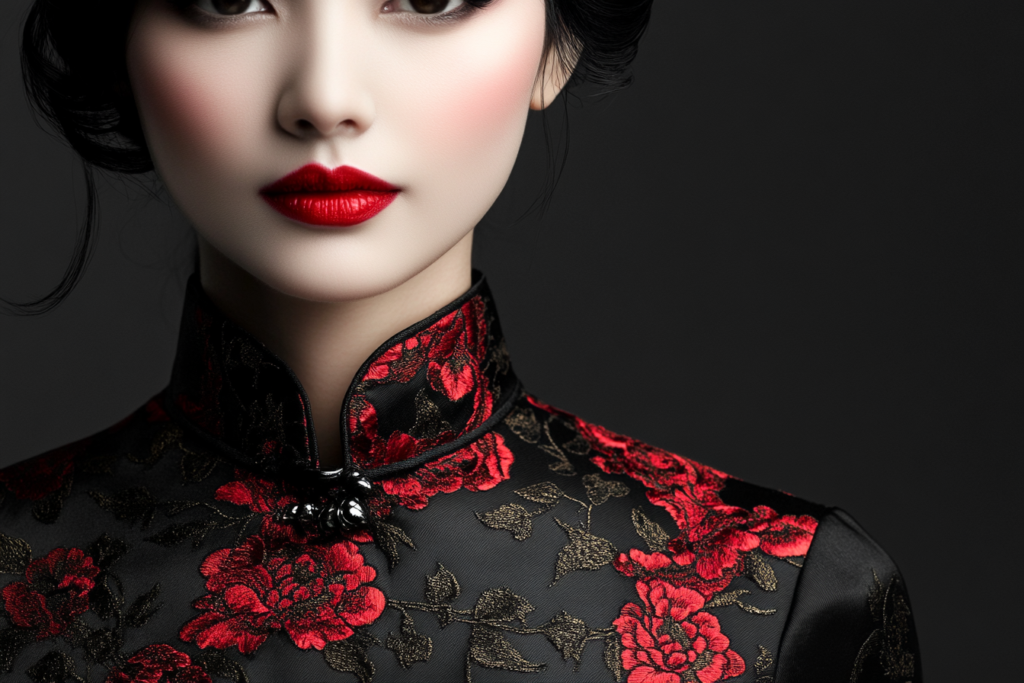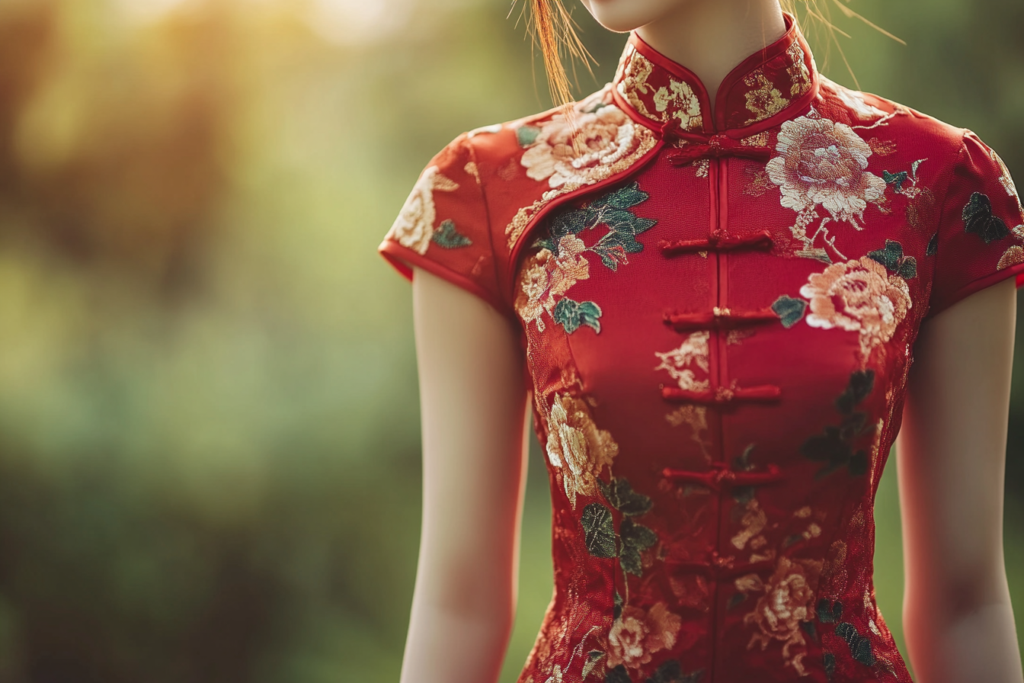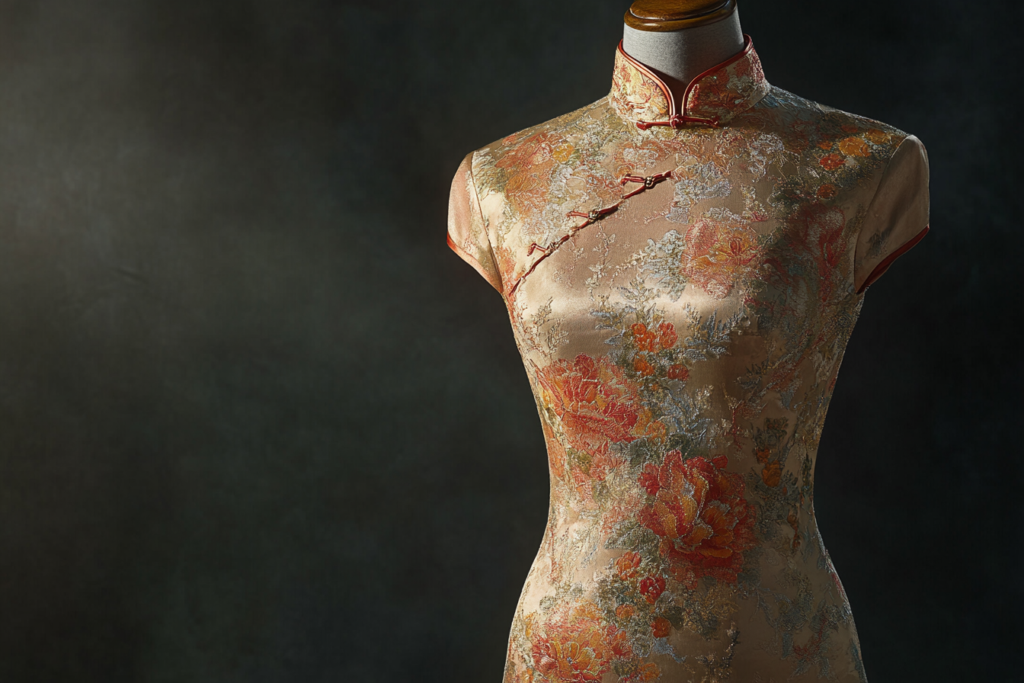Introduction: What is a Cheongsam?
The cheongsam, also known as the qipao, is a traditional Chinese dress for women that is renowned for its elegant silhouette and sophisticated design. It is characterized by its fitted structure, stand-up collar, and side slits, making it a flattering and timeless garment that has evolved in both style and significance throughout history. The cheongsam is often associated with Chinese culture, particularly from the 1920s to the mid-20th century, and remains an iconic piece in modern Chinese fashion.
In this article, we will explore the history, design elements, and cultural significance of the cheongsam, and how it has become a symbol of both traditional and modern femininity.


The Design and Features of a Cheongsam
The cheongsam is a beautifully designed dress that emphasizes femininity and elegance. Its form-fitting style and the intricate detailing of the collar and slits make it a stunning choice for both formal and informal occasions.
- Fitted Silhouette:
- One of the most distinguishing features of the cheongsam is its form-fitting design. The dress hugs the body, showcasing the wearer’s natural curves while maintaining modesty. This fitted silhouette is a defining element, emphasizing both grace and strength.
- Stand-Up Collar:
- The cheongsam typically features a stand-up collar, also called a mandarin collar, which provides a clean, structured look. This collar can be high or low, depending on the style and occasion, and adds a touch of sophistication to the overall design.
- Side Slits:
- The side slits are another iconic aspect of the cheongsam. These slits often start at the hem and rise up to just below the knee or higher, adding both ease of movement and a subtle sensuality to the garment. The slits are an important design feature that allow the wearer to walk comfortably and gracefully.
- Fabric Choices:
- Cheongsams are made from a variety of luxurious fabrics, including silk, satin, brocade, and cotton. The choice of fabric is often determined by the occasion—silk and satin are often used for formal events, while cotton versions are common for more casual wear.
- Intricate Embellishments:
- Cheongsams are often adorned with intricate embroidery, beading, or silk-thread designs. These embellishments, which may feature floral motifs, birds, or symbols of good fortune, add a layer of richness to the garment. Many cheongsams feature frog buttons, small decorative knots made from fabric, adding another cultural touch to the design.
The History of the Cheongsam
The cheongsam has a long and fascinating history, evolving over centuries to become the beloved garment it is today. It originated from the Manchu people in the Qing Dynasty, but it was during the early 20th century that it became popularized in Chinese society, especially in urban centers such as Shanghai.
- Origins in the Qing Dynasty:
- The cheongsam’s ancestors were worn by the Manchu women during the Qing Dynasty (1644–1912). These garments were loose-fitting and featured high collars and long sleeves. Over time, the design evolved, and during the early 20th century, it began to take on the more fitted, sleek silhouette that is characteristic of modern cheongsams.
- Early 20th Century and Shanghai Influence:
- In the 1920s, the cheongsam became fashionable among urban women, particularly in Shanghai. It became a symbol of modernity and sophistication. The shift from a loose, traditional garment to the figure-hugging design reflected a broader cultural shift in China as it embraced Western influences while retaining traditional elements.
- Post-1949 Adaptation:
- After the founding of the People’s Republic of China in 1949, the cheongsam saw a decline in popularity, as more practical clothing was promoted. However, it experienced a resurgence in the 1980s and 1990s as people embraced traditional Chinese culture and the garment’s timeless appeal.
- Modern Day:
- Today, the cheongsam is worn for both traditional celebrations and modern events. It is particularly popular during Chinese New Year, weddings, and other formal occasions. The cheongsam has transcended its traditional roots, appearing in modern fashion shows and being embraced by global designers.
The Cultural Significance of the Cheongsam
The cheongsam holds deep cultural significance in China and around the world. As an enduring symbol of femininity, beauty, and grace, it plays a crucial role in various cultural practices and celebrations.
- Symbol of Elegance and Femininity:
- The cheongsam is often regarded as a symbol of elegance, refinement, and femininity. Its sleek, figure-hugging design highlights the beauty of the female form, while the high collar and side slits maintain an air of modesty and sophistication.
- Cultural Identity:
- The cheongsam has come to symbolize Chinese cultural identity, especially for the Chinese diaspora. It is often worn during important cultural celebrations like Chinese New Year and Mid-Autumn Festival to honor tradition and express national pride.
- Fashion Icon:
- The cheongsam has been embraced globally and is seen in international fashion collections. Its timeless beauty and versatile design have made it a global icon, representing the fusion of Eastern and Western influences in fashion.
- Weddings and Formal Occasions:
- The cheongsam is also a popular choice for brides in Chinese weddings. The gown’s rich symbolism, combined with its elegant design, makes it an ideal garment for marking a special occasion.
How to Wear a Cheongsam
While the cheongsam is traditionally associated with formal occasions, modern interpretations allow for more versatility in styling.
- For Formal Events:
- For formal occasions like weddings, galas, and other celebrations, a cheongsam made from luxurious fabrics like silk or brocade, with delicate embroidery or embellishments, is an excellent choice. Pair it with classic accessories like pearl earrings or a statement clutch to complete the look.
- For Everyday Wear:
- The cheongsam can also be worn for more casual occasions. A cotton or linen version with fewer embellishments makes for an elegant yet comfortable everyday outfit. Pair it with simple sandals or flats for a relaxed yet chic style.
- Modern Updates:
- Designers have modernized the cheongsam by experimenting with different fabrics, patterns, and styles. Some contemporary versions feature cap sleeves, shorter skirts, or even asymmetrical designs while maintaining the signature stand-up collar and side slits.
Conclusion: The Timeless Charm of the Cheongsam
The cheongsam is more than just a dress—it’s a garment steeped in history, cultural significance, and elegance. With its sleek silhouette, stand-up collar, and side slits, the cheongsam has remained a symbol of femininity and grace for centuries. Whether worn for a wedding, a cultural celebration, or simply as a fashionable statement, the cheongsam will continue to captivate hearts around the world for generations to come.



